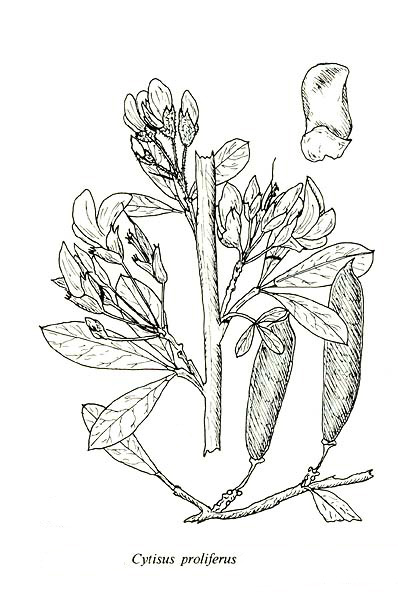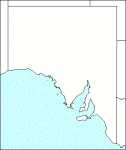Family: Fabaceae
Cytisus proliferus
Citation:
L.f., Suppl. 328 (1782).
Synonymy: Chamaecytisus proliferus (L. fi)Link, Handb. 2:154 (1831); Cytisus multiriorus sensu J. Black, Fl. S. Aust. 450 (1948), non (Aiton) Sweet.
Common name: Tree lucerne, tagasaste, silky cytisus.
Description:
Shrubs or small trees, with slender long drooping hoary branches; leaves on petioles 5-15 mm long, the leaflets lanceolate, 10-30 x 3-15 mm, the central leaflet distant from the lateral ones, quite glabrous above, with silky appressed hairs underneath and a conspicuous midrib; stipules inconspicuous, bud-like, pubescent.
Flowers in lateral sessile umbels of 3-7 (or more), on slender pubescent pedicels 3-10 mm long; bracts subulate, c. 4 mm long, glabrous to densely pubescent bracteoles inserted below the calyx, subulate, c. 5 mm long, densely pubescent, deciduous; calyx tubular, c. 10 mm long, 2-lipped, pubescent; the upper lobe shorter, with 2 divaricate teeth; lower lip longer; the 3 lobes lying close together, appearing as one due to the woolly pubescence, persistent; petals white; standard reniform, c. 15 mm long, folded back at the sides, pubescent on the back medially; keel considerably shorter; ovary pubescent; style merely incurved, with a small capitate stigma.
Pod on a stalk to 15 mm long, narrowly oblong in outline, flat, 40-50 x c. 12 mm, sericeous, with ridges along the margins, c. 10-seeded; seed elliptical-cordate, c. 4 x 3 mm; laterally compressed, dark-brown to black, smooth, shiny; aril pale-yellow, large, cup-shaped, emarginate.

| Cytisus proliferus twig, legumes and seed.
|
Image source: fig 381a in Jessop J.P. & Toelken H.R. (Ed.) 1986. Flora of South Australia (4th edn).
|
Published illustration:
Cunningham et al. (1982) Plants of western New South Wales, p. 386.
|
|
Distribution:
|
Grown as a hedge and spontaneous in disturbed areas.
W.Aust.; N.S.W.; Vic.; Tas. Originated from the Canary Islands, where it is known as "tagasaste".
|
Conservation status:
naturalised
Flowering time: July — Oct.
|

SA Distribution Map based
on current data relating to
specimens held in the
State Herbarium of South Australia
|
Biology:
The name proliferus apparently originated from the circumstance of young shoots springing from the centre of the umbel and the inflorescence becoming proliferous. (Sims (1817) Curtis's Bot. Mag. 44:t. 1908).
Author:
Not yet available
|

